Module 1 Unit 2 Travelling around the world Focusing on culture 课件(共22张PPT,内嵌音频)——2024-2025学年七年级下册《英
文档属性
| 名称 | Module 1 Unit 2 Travelling around the world Focusing on culture 课件(共22张PPT,内嵌音频)——2024-2025学年七年级下册《英 |

|
|
| 格式 | pptx | ||
| 文件大小 | 118.7MB | ||
| 资源类型 | 教案 | ||
| 版本资源 | 牛津深圳版 | ||
| 科目 | 英语 | ||
| 更新时间 | 2025-02-25 22:04:21 | ||
图片预览

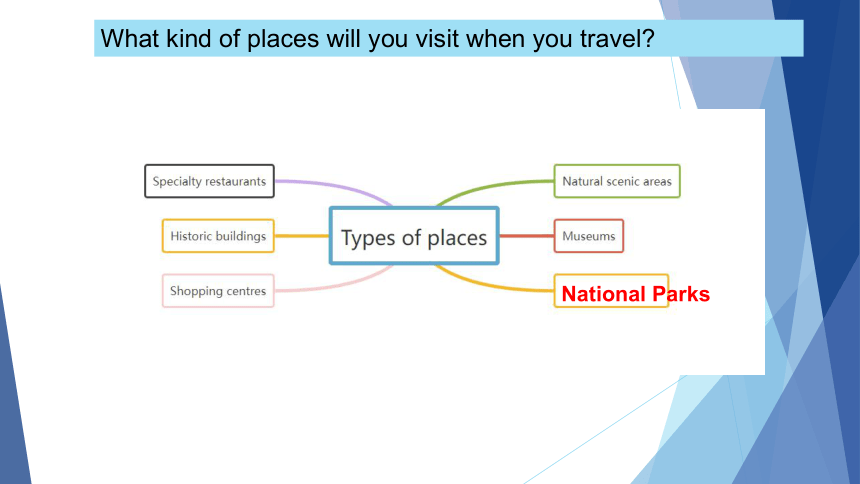
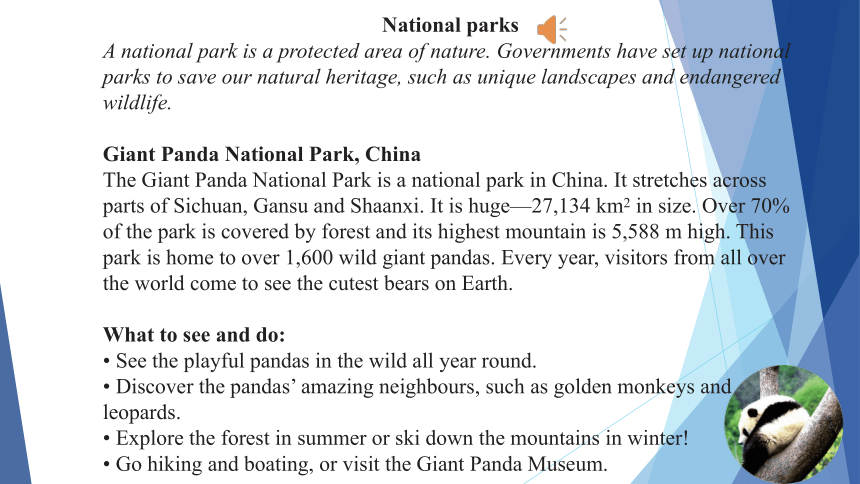
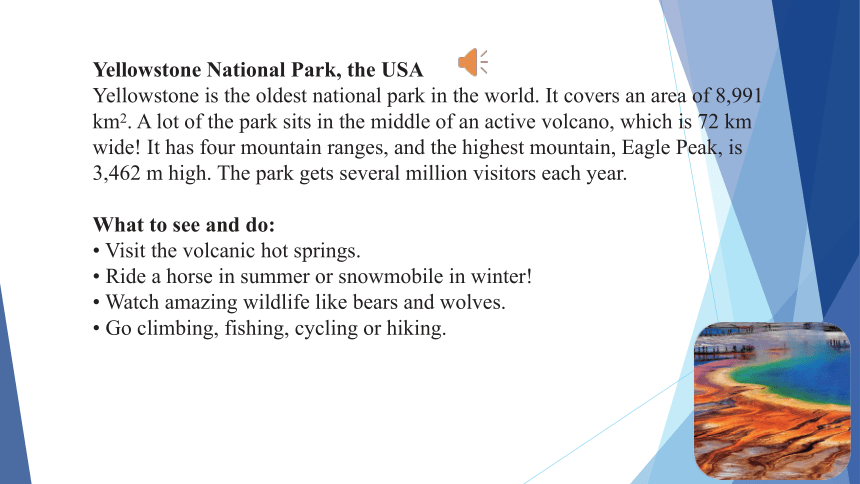
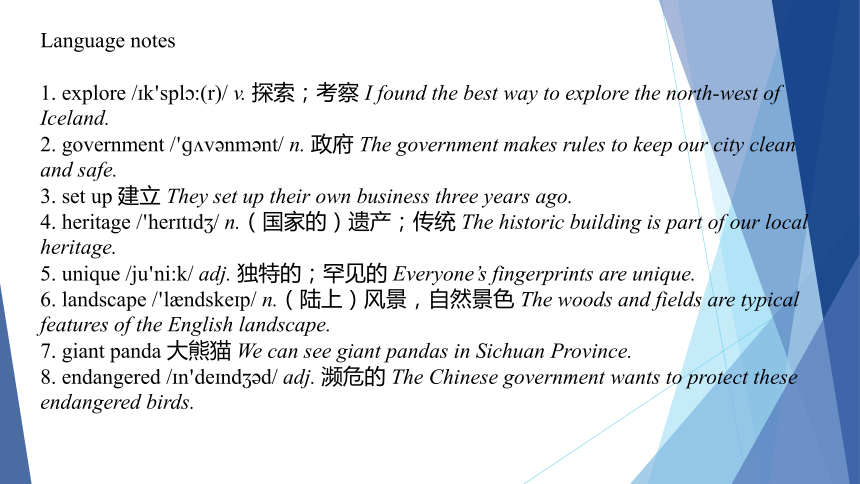

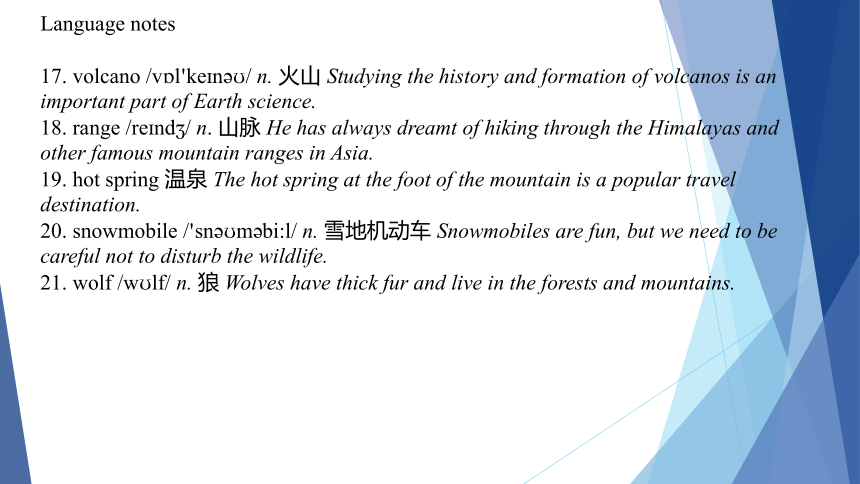
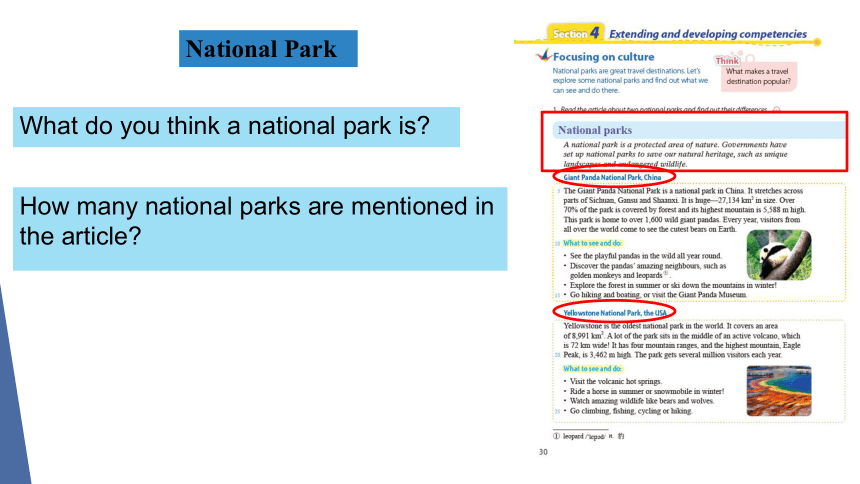
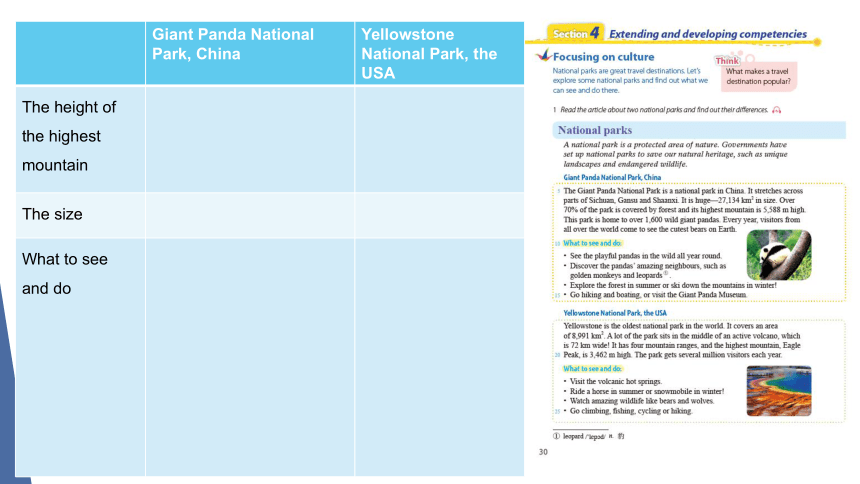
文档简介
(共22张PPT)
What kind of places will you visit when you travel
National Parks
National parks
A national park is a protected area of nature. Governments have set up national parks to save our natural heritage, such as unique landscapes and endangered wildlife.
Giant Panda National Park, China
The Giant Panda National Park is a national park in China. It stretches across parts of Sichuan, Gansu and Shaanxi. It is huge—27,134 km2 in size. Over 70% of the park is covered by forest and its highest mountain is 5,588 m high. This park is home to over 1,600 wild giant pandas. Every year, visitors from all over the world come to see the cutest bears on Earth.
What to see and do:
See the playful pandas in the wild all year round.
Discover the pandas’ amazing neighbours, such as golden monkeys and leopards.
Explore the forest in summer or ski down the mountains in winter!
Go hiking and boating, or visit the Giant Panda Museum.
Yellowstone National Park, the USA
Yellowstone is the oldest national park in the world. It covers an area of 8,991 km2. A lot of the park sits in the middle of an active volcano, which is 72 km wide! It has four mountain ranges, and the highest mountain, Eagle Peak, is 3,462 m high. The park gets several million visitors each year.
What to see and do:
Visit the volcanic hot springs.
Ride a horse in summer or snowmobile in winter!
Watch amazing wildlife like bears and wolves.
Go climbing, fishing, cycling or hiking.
Language notes
1. explore /Ik9splO:(r)/ v. 探索;考察 I found the best way to explore the north-west of Iceland.
2. government /9GVvRnmRnt/ n. 政府 The government makes rules to keep our city clean and safe.
3. set up 建立 They set up their own business three years ago.
4. heritage /9herItIdZ/ n.(国家的)遗产;传统 The historic building is part of our local heritage.
5. unique /ju9ni:k/ adj. 独特的;罕见的 Everyone’s fingerprints are unique.
6. landscape /9l ndskeIp/ n.(陆上)风景,自然景色 The woods and fields are typical features of the English landscape.
7. giant panda 大熊猫 We can see giant pandas in Sichuan Province.
8. endangered /In9deIndZRd/ adj. 濒危的 The Chinese government wants to protect these endangered birds.
Language notes
9. stretch /stretS/ v. 延伸;绵延 The Andes stretch for over 7,000 kilometers along the west coast of South America.
10. huge /hju:dZ/ adj. 巨大的;极多的 A huge number of people crowded into the supermarket.
11. home to ... ……的家园 The forest is home to wild animals.
12. in the wild 在野外 Tigers are powerful animals in the wild.
13. all year round 全年 The market sells fresh fruits and vegetables all year round.
14. discover /dI9skVvR(r)/ v. 了解到;查明 We still haven’t discovered why he quit school.
15. golden monkey 金丝猴 Golden monkeys are known for their shiny golden fur.
16. go hiking 去远足 Going hiking is a great way to get exercise in nature.
Language notes
17. volcano /vBl9keInRW/ n. 火山 Studying the history and formation of volcanos is an important part of Earth science.
18. range /reIndZ/ n. 山脉 He has always dreamt of hiking through the Himalayas and other famous mountain ranges in Asia.
19. hot spring 温泉 The hot spring at the foot of the mountain is a popular travel destination.
20. snowmobile /9snRWmRbi:l/ n. 雪地机动车 Snowmobiles are fun, but we need to be careful not to disturb the wildlife.
21. wolf /wWlf/ n. 狼 Wolves have thick fur and live in the forests and mountains.
National Park
What do you think a national park is
How many national parks are mentioned in the article
Giant Panda National Park, China Yellowstone National Park, the USA
The height of the highest mountain
The size
What to see and do
Giant Panda National Park, China Yellowstone National Park, the USA
The height of the highest mountain Its highest mountain is 5,588 m high. Eagle Peak is 3,462 m high.
The size It is huge—27,134 km2. It covers an area of 8,991km2.
What to see and do See the playful pandas in the wild all year round. Discover the pandas’ amazing neighbours, such as golden monkeys and leopards. Explore the forest in summer or ski down the mountains in winter. Go hiking and boating, or visit the Giant Panda Museum. Visit the volcanic hot springs.
Ride a horse in summer or snowmobile in winter.
Watch amazing wildlife like bears and wolves.
Go climbing, fishing, cycling or hiking.
discovered
set up /has set up
huge
range
Wild
(1) What have you learnt about the Grand Canyon from the video clip
(2) What are some ways of exploring the Grand Canyon
Basic information about the Grand Canyon, what I can see and do there, and how I can explore the park.
Visitors can explore the Grand Canyon on foot, by bus or on a bike. They can also see the Grand Canyon by steam train, by helicopter or by raft.
What national parks in China do you know
Three-River-Source(Sanjiangyuan) National Park
Potatso (Pudacuo) National Park
Northeast Tiger Leopard National Park
Shennongjia National Park
Qianjiangyuan National Park
Nanshan National Park
Wuyishan National Park
Great Wall National Park
Zhangjiajie National Forest Park
…
The formation of the mountains in Zhangjiajie
People are always amazed by the pillarlike mountains in Zhangjiajie, but how did these unique mountains take shape The story started at the bottom of the sea. Here, the forces of nature turn sand into stone. How does this happen Well, many of the world’s rivers pick up sand and slowly carry it into the ocean. Little by little, new sand arrives on the sea floor, so the old sand gets pressed down. It can take millions of years, but the pressure slowly turns the sand into hard rock. This is what happened in Zhangjiajie.
Later, the sea floor slowly rose out of the water and became land, and the hard sandstone of Zhangjiajie began cracking up. The wind kept blowing against the rock, and rivers passed through the cracks. These forces of nature slowly cut deeper and deeper, and the land continued to rise. Over time, strange-looking sandstone mountains appeared. In fact, wind and water continue to wear down the mountains. Sometime in the future, millions of years from now, these beautiful mountains will disappear.
Language notes
1. formation /fO:9meISn/ n. 形成;建立 Water is needed in the formation of clouds.
2. at the bottom of 在……的底部 Answers can be found at the bottom of page 8.
3. turn ... into ... (使)……变成…… By recycling plastic bottles, we can turn waste into resources.
4. pick up 拿起;拾起;提起 He picked up his hat from the floor and put it on his head.
5. little by little 渐渐 By reading books for 30 minutes every day, she improved her English little by little.
6. press down 把……按下去 When planting flowers, it’s important to gently press down the soil around the seeds.
7. rise /raIz/ v. 上升;升高 He watched the smoke rise from the fire.
Language notes
8. keep doing something 不断做某事 You need to keep practising if you want to be a great musician.
9. continue to do 继续做某事 The rain continued to fall all night.
10. wear down 磨平;磨光 The constant flow of water wore down the rocks in the river.
11. feature /9fi:tSR(r)/ n. 特征;特色 The waterfall is a major feature of the park.
Read the passage and write down the steps about how the mountains shaped.
01
Rivers picked up sand.
02
Rivers carried it into the ocean slowly.
03
New sand arrived on the sea floor.
10
The strange-looking sandstone mountains appeared.
09
The land continued to rise.
08
The forces of nature cut the sandstone deeper and deeper.
04
Old sand got pressed down.
07
The hard sandstone began cracking up.
05
The sand turned into hard rock.
06
The sea floor slowly rose out of the water and became land.
d
a
b
c
e
Retell the story of the formation of the mountains in Zhangjiajie. Use the key words below to help you.
… picked up…
… carried into …
… arrived …
… pressed down
… turned into …
… rose out of …
… cracking up …
… cut …
… continued to …
… appeared
评价内容 评分(1—5)
1. Content accuracy(All key points are included with no errors.) 1 2 3 4 5
2. Language use (The language is accurate and the grammar is correct.) 1 2 3 4 5
3. Organization (The structure is clear and logical, and there is a smooth transition between different points.) 1 2 3 4 5
4. Pronunciation and intonation (The pronunciation is clear, and the intonation is natural and appropriate.) 1 2 3 4 5
5. Facial expressions and body language (The body language and facial expressions are natural.) 1 2 3 4 5
Think
What makes a travel destination popular
Natural scenery
Special culture and customs
Comfortable climate
Convenience of transportation
…
Homework
基础作业
选择一个国家公园,制作一个幻灯片进行介绍,包括其地理位置、特色资源及文化意义。
拓展作业
小组合作制作一份中国国家公园分布图,在地图上标注其地理位置。根据所保护对象进行分类,如动物、植物、地貌等。
THANK YOU
What kind of places will you visit when you travel
National Parks
National parks
A national park is a protected area of nature. Governments have set up national parks to save our natural heritage, such as unique landscapes and endangered wildlife.
Giant Panda National Park, China
The Giant Panda National Park is a national park in China. It stretches across parts of Sichuan, Gansu and Shaanxi. It is huge—27,134 km2 in size. Over 70% of the park is covered by forest and its highest mountain is 5,588 m high. This park is home to over 1,600 wild giant pandas. Every year, visitors from all over the world come to see the cutest bears on Earth.
What to see and do:
See the playful pandas in the wild all year round.
Discover the pandas’ amazing neighbours, such as golden monkeys and leopards.
Explore the forest in summer or ski down the mountains in winter!
Go hiking and boating, or visit the Giant Panda Museum.
Yellowstone National Park, the USA
Yellowstone is the oldest national park in the world. It covers an area of 8,991 km2. A lot of the park sits in the middle of an active volcano, which is 72 km wide! It has four mountain ranges, and the highest mountain, Eagle Peak, is 3,462 m high. The park gets several million visitors each year.
What to see and do:
Visit the volcanic hot springs.
Ride a horse in summer or snowmobile in winter!
Watch amazing wildlife like bears and wolves.
Go climbing, fishing, cycling or hiking.
Language notes
1. explore /Ik9splO:(r)/ v. 探索;考察 I found the best way to explore the north-west of Iceland.
2. government /9GVvRnmRnt/ n. 政府 The government makes rules to keep our city clean and safe.
3. set up 建立 They set up their own business three years ago.
4. heritage /9herItIdZ/ n.(国家的)遗产;传统 The historic building is part of our local heritage.
5. unique /ju9ni:k/ adj. 独特的;罕见的 Everyone’s fingerprints are unique.
6. landscape /9l ndskeIp/ n.(陆上)风景,自然景色 The woods and fields are typical features of the English landscape.
7. giant panda 大熊猫 We can see giant pandas in Sichuan Province.
8. endangered /In9deIndZRd/ adj. 濒危的 The Chinese government wants to protect these endangered birds.
Language notes
9. stretch /stretS/ v. 延伸;绵延 The Andes stretch for over 7,000 kilometers along the west coast of South America.
10. huge /hju:dZ/ adj. 巨大的;极多的 A huge number of people crowded into the supermarket.
11. home to ... ……的家园 The forest is home to wild animals.
12. in the wild 在野外 Tigers are powerful animals in the wild.
13. all year round 全年 The market sells fresh fruits and vegetables all year round.
14. discover /dI9skVvR(r)/ v. 了解到;查明 We still haven’t discovered why he quit school.
15. golden monkey 金丝猴 Golden monkeys are known for their shiny golden fur.
16. go hiking 去远足 Going hiking is a great way to get exercise in nature.
Language notes
17. volcano /vBl9keInRW/ n. 火山 Studying the history and formation of volcanos is an important part of Earth science.
18. range /reIndZ/ n. 山脉 He has always dreamt of hiking through the Himalayas and other famous mountain ranges in Asia.
19. hot spring 温泉 The hot spring at the foot of the mountain is a popular travel destination.
20. snowmobile /9snRWmRbi:l/ n. 雪地机动车 Snowmobiles are fun, but we need to be careful not to disturb the wildlife.
21. wolf /wWlf/ n. 狼 Wolves have thick fur and live in the forests and mountains.
National Park
What do you think a national park is
How many national parks are mentioned in the article
Giant Panda National Park, China Yellowstone National Park, the USA
The height of the highest mountain
The size
What to see and do
Giant Panda National Park, China Yellowstone National Park, the USA
The height of the highest mountain Its highest mountain is 5,588 m high. Eagle Peak is 3,462 m high.
The size It is huge—27,134 km2. It covers an area of 8,991km2.
What to see and do See the playful pandas in the wild all year round. Discover the pandas’ amazing neighbours, such as golden monkeys and leopards. Explore the forest in summer or ski down the mountains in winter. Go hiking and boating, or visit the Giant Panda Museum. Visit the volcanic hot springs.
Ride a horse in summer or snowmobile in winter.
Watch amazing wildlife like bears and wolves.
Go climbing, fishing, cycling or hiking.
discovered
set up /has set up
huge
range
Wild
(1) What have you learnt about the Grand Canyon from the video clip
(2) What are some ways of exploring the Grand Canyon
Basic information about the Grand Canyon, what I can see and do there, and how I can explore the park.
Visitors can explore the Grand Canyon on foot, by bus or on a bike. They can also see the Grand Canyon by steam train, by helicopter or by raft.
What national parks in China do you know
Three-River-Source(Sanjiangyuan) National Park
Potatso (Pudacuo) National Park
Northeast Tiger Leopard National Park
Shennongjia National Park
Qianjiangyuan National Park
Nanshan National Park
Wuyishan National Park
Great Wall National Park
Zhangjiajie National Forest Park
…
The formation of the mountains in Zhangjiajie
People are always amazed by the pillarlike mountains in Zhangjiajie, but how did these unique mountains take shape The story started at the bottom of the sea. Here, the forces of nature turn sand into stone. How does this happen Well, many of the world’s rivers pick up sand and slowly carry it into the ocean. Little by little, new sand arrives on the sea floor, so the old sand gets pressed down. It can take millions of years, but the pressure slowly turns the sand into hard rock. This is what happened in Zhangjiajie.
Later, the sea floor slowly rose out of the water and became land, and the hard sandstone of Zhangjiajie began cracking up. The wind kept blowing against the rock, and rivers passed through the cracks. These forces of nature slowly cut deeper and deeper, and the land continued to rise. Over time, strange-looking sandstone mountains appeared. In fact, wind and water continue to wear down the mountains. Sometime in the future, millions of years from now, these beautiful mountains will disappear.
Language notes
1. formation /fO:9meISn/ n. 形成;建立 Water is needed in the formation of clouds.
2. at the bottom of 在……的底部 Answers can be found at the bottom of page 8.
3. turn ... into ... (使)……变成…… By recycling plastic bottles, we can turn waste into resources.
4. pick up 拿起;拾起;提起 He picked up his hat from the floor and put it on his head.
5. little by little 渐渐 By reading books for 30 minutes every day, she improved her English little by little.
6. press down 把……按下去 When planting flowers, it’s important to gently press down the soil around the seeds.
7. rise /raIz/ v. 上升;升高 He watched the smoke rise from the fire.
Language notes
8. keep doing something 不断做某事 You need to keep practising if you want to be a great musician.
9. continue to do 继续做某事 The rain continued to fall all night.
10. wear down 磨平;磨光 The constant flow of water wore down the rocks in the river.
11. feature /9fi:tSR(r)/ n. 特征;特色 The waterfall is a major feature of the park.
Read the passage and write down the steps about how the mountains shaped.
01
Rivers picked up sand.
02
Rivers carried it into the ocean slowly.
03
New sand arrived on the sea floor.
10
The strange-looking sandstone mountains appeared.
09
The land continued to rise.
08
The forces of nature cut the sandstone deeper and deeper.
04
Old sand got pressed down.
07
The hard sandstone began cracking up.
05
The sand turned into hard rock.
06
The sea floor slowly rose out of the water and became land.
d
a
b
c
e
Retell the story of the formation of the mountains in Zhangjiajie. Use the key words below to help you.
… picked up…
… carried into …
… arrived …
… pressed down
… turned into …
… rose out of …
… cracking up …
… cut …
… continued to …
… appeared
评价内容 评分(1—5)
1. Content accuracy(All key points are included with no errors.) 1 2 3 4 5
2. Language use (The language is accurate and the grammar is correct.) 1 2 3 4 5
3. Organization (The structure is clear and logical, and there is a smooth transition between different points.) 1 2 3 4 5
4. Pronunciation and intonation (The pronunciation is clear, and the intonation is natural and appropriate.) 1 2 3 4 5
5. Facial expressions and body language (The body language and facial expressions are natural.) 1 2 3 4 5
Think
What makes a travel destination popular
Natural scenery
Special culture and customs
Comfortable climate
Convenience of transportation
…
Homework
基础作业
选择一个国家公园,制作一个幻灯片进行介绍,包括其地理位置、特色资源及文化意义。
拓展作业
小组合作制作一份中国国家公园分布图,在地图上标注其地理位置。根据所保护对象进行分类,如动物、植物、地貌等。
THANK YOU
